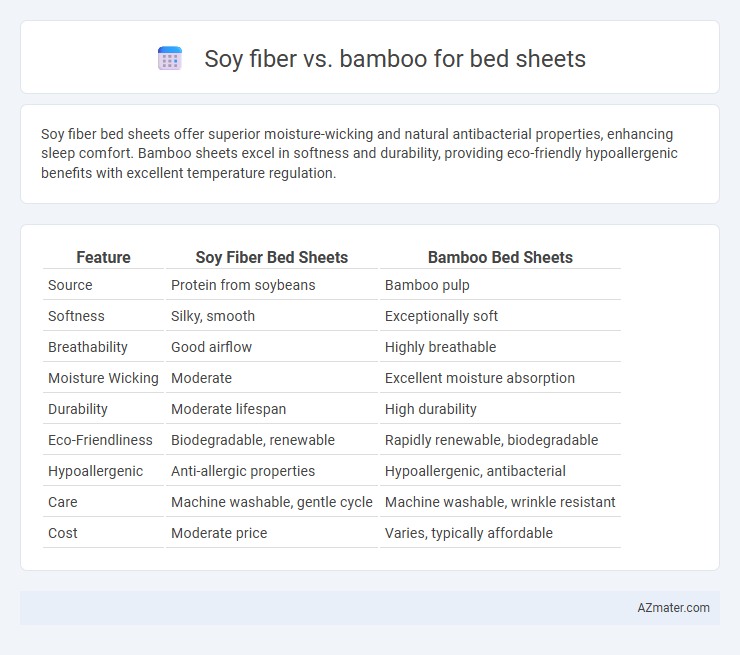Soy fiber bed sheets offer superior moisture-wicking and natural antibacterial properties, enhancing sleep comfort. Bamboo sheets excel in softness and durability, providing eco-friendly hypoallergenic benefits with excellent temperature regulation.
Table of Comparison
| Feature | Soy Fiber Bed Sheets | Bamboo Bed Sheets |
|---|---|---|
| Source | Protein from soybeans | Bamboo pulp |
| Softness | Silky, smooth | Exceptionally soft |
| Breathability | Good airflow | Highly breathable |
| Moisture Wicking | Moderate | Excellent moisture absorption |
| Durability | Moderate lifespan | High durability |
| Eco-Friendliness | Biodegradable, renewable | Rapidly renewable, biodegradable |
| Hypoallergenic | Anti-allergic properties | Hypoallergenic, antibacterial |
| Care | Machine washable, gentle cycle | Machine washable, wrinkle resistant |
| Cost | Moderate price | Varies, typically affordable |
Introduction to Soy Fiber and Bamboo Bed Sheets
Soy fiber bed sheets are crafted from natural soybean protein, offering a soft, breathable, and eco-friendly alternative for sustainable bedding. Bamboo bed sheets, made from bamboo pulp, are known for their moisture-wicking properties, hypoallergenic nature, and durability, making them ideal for sensitive skin. Both materials provide luxurious comfort while supporting environmentally conscious choices in home textiles.
Understanding the Materials: Soy Fiber vs Bamboo
Soy fiber bed sheets, derived from the byproduct of soybean processing, offer a soft texture and excellent moisture-wicking properties, making them breathable and hypoallergenic. Bamboo bed sheets, crafted from bamboo pulp, are renowned for their durability, natural antibacterial properties, and ability to regulate temperature effectively. While both fibers provide eco-friendly alternatives, bamboo sheets typically excel in strength and longevity, whereas soy fiber sheets prioritize softness and comfort.
Production Process: Eco-Friendliness and Sustainability
Soy fiber bed sheets are produced from byproducts of soybean processing, utilizing a natural protein fiber that reduces waste and requires less water and pesticides compared to conventional cotton. Bamboo bed sheets are derived from bamboo grass through mechanical or chemical processes, with the mechanical method being more eco-friendly as it preserves natural fibers without harsh chemicals, while the chemical method involves solvents that can impact the environment. Both fibers offer sustainable alternatives, but soy fiber production emphasizes waste valorization and lower resource usage, whereas bamboo's sustainability depends heavily on the processing technique employed.
Comfort and Softness: A Detailed Comparison
Soy fiber bed sheets offer exceptional softness due to their smooth, silk-like texture and excellent moisture-wicking properties, making them ideal for sensitive skin and hot sleepers. Bamboo sheets stand out for their natural breathability and hypoallergenic traits, providing a cool, silky feel that resists odors and allergens effectively. Both fibers excel in comfort, but soy fiber tends to be softer, while bamboo offers superior temperature regulation and durability.
Breathability and Moisture-Wicking Properties
Soy fiber bed sheets offer excellent breathability due to their natural cellulose composition, allowing air circulation that keeps sleepers cool and comfortable. Bamboo sheets are renowned for their superior moisture-wicking properties, efficiently pulling sweat away from the body to maintain dryness throughout the night. Both fabrics provide exceptional cooling performance, but bamboo's enhanced moisture management makes it ideal for hot, humid climates.
Durability and Longevity of Soy Fiber vs Bamboo Sheets
Soy fiber bed sheets offer moderate durability, maintaining softness through multiple washes but tend to show wear faster than bamboo sheets. Bamboo sheets, made from highly resilient viscose fibers, exhibit superior longevity due to their natural strength and resistance to pilling and fading. Consumers seeking long-lasting bedding often prefer bamboo for its enhanced durability and sustained quality over time.
Hypoallergenic and Skin-Friendly Qualities
Soy fiber bed sheets offer excellent hypoallergenic properties due to their natural protein content, which resists bacteria and allergens, making them ideal for sensitive skin and allergy sufferers. Bamboo sheets feature antimicrobial and moisture-wicking qualities, enhancing skin comfort by reducing irritation and preventing the growth of harmful microbes. Both materials provide breathable, soft textures, but bamboo's superior moisture management typically makes it more effective for maintaining a fresh, skin-friendly sleep environment.
Care and Maintenance Requirements
Soy fiber bed sheets require gentle washing in cold water with mild detergent and should be air-dried or tumble dried on low heat to maintain softness and durability. Bamboo sheets are naturally moisture-wicking and resistant to odors but need washing in cold water with a gentle cycle to preserve their smooth texture and prevent shrinkage. Both fibers benefit from avoiding bleach and fabric softeners, which can degrade the fibers and reduce fabric lifespan.
Cost and Value for Money
Soy fiber bed sheets tend to be more affordable than bamboo, offering a budget-friendly option with decent softness and durability. Bamboo sheets are generally pricier but provide superior breathability, moisture-wicking properties, and long-lasting resilience, delivering higher value for consumers seeking premium comfort. Investing in bamboo can result in better overall comfort and longevity, whereas soy fiber suits those prioritizing cost savings without sacrificing too much quality.
Conclusion: Which Bed Sheet Material is Better?
Soy fiber bed sheets offer excellent softness, moisture-wicking properties, and natural antimicrobial benefits, making them ideal for sensitive skin and warm climates. Bamboo bed sheets provide superior breathability, durability, and eco-friendly attributes, often preferred for sustainable bedding choices. For ultimate comfort combined with environmental responsibility, bamboo sheets generally outperform soy fiber in longevity and moisture management.

Infographic: Soy fiber vs Bamboo for Bed sheet
 azmater.com
azmater.com